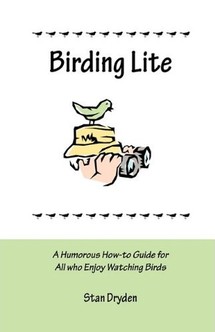Reviewed by Grant McCreary on February 2nd, 2010.
Those of us who have been bitten by the bug can attest that bird watching is a great hobby; it’s educational, takes you to some wonderful places, and fun. And to get started, all you have to do – it’s right there in the name – is watch birds. Easy, right? Well, not so fast. First, you have to find a bird, then you will need to see it well, and you’ll probably want to pin a name to it. And that’s just for starters. Thankfully, would-be and beginning birders have a slew of how-to guides for getting started available to them, including this latest one by Stan Dryden.
Birding Lite presents the items and knowledge readers will need to start birding. The chapters on bird identification, field guides and other references, and optics are good primers on the subjects. Attracting birds, both through sounds (i.e. pishing and recordings) and backyard enticements, is given a very brief overview.
A chapter on “whole-brain birding” was a surprising inclusion. In it, Dryden encourages birders to appreciate birds both analytically (left brain) and intuitively (right brain). This would be an intriguing topic for an article, but I’m not sure that it belongs here. On the other hand, a chapter on bird names was a really good idea. The author separates common names into 10 categories. Some are obvious, like those that describe appearance, or birds that are named after people. Others, like “names with fascinating derivations”, are bizarre but interesting. I can see how this section would be a great help for new birders.
The final three chapters show the prospective birder what the future may hold for them. More advanced topics like listing, rarity chasing, and competitive birding are outlined. And a book about how to bird just wouldn’t be complete without a discussion of some difficult identifications. Well, it’s more of a brief mention than discussion; gulls, sparrows, and warblers are the only groups given much attention at all.
Birding Lite keeps well away from any of the more technical topics like migration, variation, or (eep!) molt. There is nary a topography diagram to be found. In fact, there are very few illustrations, other than some black-and-white photographs and drawings. Birders need to understand these concepts, thus this guide is far from complete. But that also makes it unintimidating and accessible. Whether this is a pro or a con largely depends on your level of experience and interest in birding.
However, there are a few omissions that are really surprising. Portable CD players and digital voice recorders (introduced earlier in the book) are the only methods of playing bird sounds in the field that are mentioned! Umm, iPod? MP3 devices are so much easier to use for this (while many recorders can store and playback prerecorded mp3’s, they aren’t nearly as easy to use for this purpose). Also, no internet sites are given as further references. In fact, very few websites are mentioned at all. Some links to birding organizations or other places that new birders can get connected would have been useful.
It is unlikely that experienced birders will find anything here to make them “better”, at least in terms of finding and identifying birds. But I think every birder could do well by modeling Dryden’s attitude toward birding: “perhaps those of us who spend time watching birds could take a cue from them and make this pastime as enjoyable and stress-free as possible”. I don’t think it’s a coincidence that the best birders I know, along with many famous birders I’ve heard like Pete Dunne and Kenn Kaufman, really enjoy watching birds. Although it’s a serious pursuit for them, or even a full-blown profession, they don’t loose sight of the “lite” side of birding. More so than any specific tip in the book, the author’s overall approach is probably the most valuable insight, and equally applicable for novices and experts alike.
This attitude is also evident in the author’s words. His writing style is very casual and conversational. But I found the book to be more lighthearted than truly humorous. It elicited a chuckle every now and then, but don’t expect to be rolling on the floor.
Recommendation
Birding Lite is perfect for those who are curious about bird watching or just getting into it. They will find the information required to get started presented in a fun, though shallow, manner.
But if you’re already sure that birding is for you and want to dive right in, then I’d recommend skipping this primer and proceeding directly to more meaty guides, particularly Pete Dunne on Bird Watching and National Geographic Birding Essentials
.
More information, including chapter summaries, are available on the Birding Lite website.
Here are some more Books for Beginning Birders
Disclosure: I get a small commission for purchases made through links in this post.
Disclosure: The item reviewed here was a complementary review copy provided by the author. But the opinion expressed here is my own, it has not been influenced in any way.



Nicely reviewed Grant. It sounds as if the author was trying for something akin to the work of Bill Oddie or Sean Dooley but came up a bit short.
Thanks, John. I hate to admit it, but I still haven’t read any of Oddie’s works. But from what I know of him, that sounds like it could be an apt comparison. I definitely didn’t find it to be as funny as Dooley’s Big Twitch.
Good review–I haven’t read it yet, but look forward to doing so!
[…] Review: Birding Lite: A Humorous How-to Guide for All Who Enjoy … […]